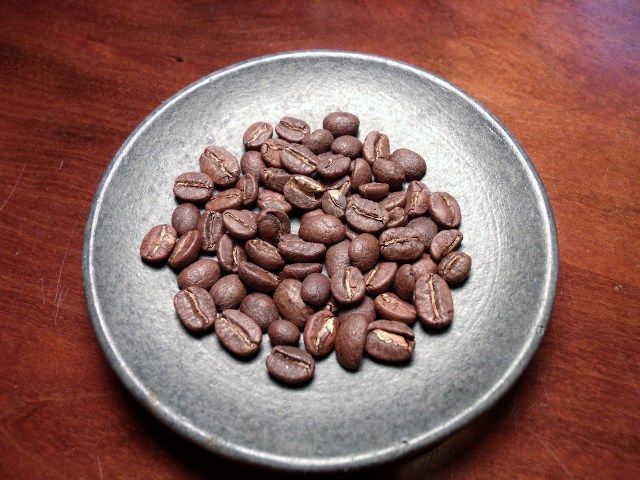Coffee Tasting - Home-roasted Guatemala Xinabajul Familia Villatoro
A rainy Saturday morning is the perfect time for a coffee tasting. This is the first Steemit coffee review that I've done - hopefully it will become a regular feature.
| Origin | Coffee | Source | Roast Date | Tasting Date |
|---|---|---|---|---|
| Guatemala | Xinabajul Familia Villatoro | Sweet Maria's | 8/29/17 | 9/2/17 |

Guatemalan coffee is easy to roast and very forgiving. Any fully developed roast between City (light) and Vienna (nearly French Roast) will be tasty. I like darker roasts and many Guatemalans can hold up well at high temperatures. This particular roast is a happy medium.
| Preheat | Batch Size | First Crack | Second Crack | Total Time | Roast Level |
|---|---|---|---|---|---|
| 475 F | 350 g | 10:00 | none | 15:45 | Full City |

I made a post a while back that talks about the coffee roasting process and how I do it at home. This batch was done just like the one in the video. First Crack refers to a popping sound, similar to popcorn, that the beans make as the moisture inside the bean vaporizes. Second Crack is a snapping sound that happens at the end of the roast when the cellulose structure of the bean starts to break down. A City Roast is a light roast that is pulled off the heat right near the end of First Crack. French Roast is a dark roast that is allowed to go well into Second Crack.
The roast progression is: First Crack > City > City+ > Full City > Second Crack Starts > Vienna > Second Crack Peaks > French > Charcoal > Get Fire Extinquisher

The traditional cupping process is a little different than making a cup of coffee. About 15 grams of roasted beans are pulverized to fine dust, much finer than for any normal coffee brewing system, and 100 milliliters of hot water are stirred in briefly. The coffee is allowed to sit undisturbed for 4 minutes and a foamy crust forms on the top. The taster can evaluate the coffee aroma of the dry grounds and the wet grounds as he/she is preparing the cup.

After four minutes, the taster stirs the floating crust into the cup and inhales a concentrated whiff of the most wonderful scent in the known Universe. It takes another minute or two for the grounds to settle to the bottom of the cup and then the taster lifts a spoonful of liquid from the top to slurp it noisily. It is a totally undignified way to drink coffee, but very effective at distributing the flavor over the palate.
| Characteristic | Score | Observations |
|---|---|---|
| Grind Aroma | 85 | wheat, fruit, molasses, bitter cocoa |
| Wet Aroma | 88 | raw sugar, malt, sweet cocoa, dark fruit jam |
| Brightness | 86 | apple-like |
| Flavor | 89 | dark fruit, ginger, prune, bitter cocoa |
| Sweetness | 88 | soft crack candy, caramel, amber malt extract |
| Body | 87 | heavy, syrupy, increasing as it cools |
| Finish | 87 | clean, malty |
| Complexity | 86 | well rounded cup, many different flavors play off each other |
The final test, at least in my opinion, is a real cup of brewed coffee at normal table strength. My preferred brewing method is the Aeropress - in this case I used two scoops (30 g) and made a half-batch. My favorite feature of this roast is the combination of dark fruit flavors and caramel/malt flavors. It reminds me of some of the darker types of brewing grain like dark crystal and Special B.
What a nice way to start a rainy Saturday morning. Please let me know if you want to see more reviews of home-roasted coffee.
Yes more reviews, it is too complicated a system for me to do, and my sense of smell is shot, (chemical fumes from very early job). And I like a good cup o coffee, so someone has to review, and make recommendations.
This is really interesting. I've heard of cupping but didn't know what tasters actually did. I liked the way you reviewed the coffee as well. Thanks for sharing!
This is great timing - both my cousin and sibling recently started roasting their own beans. My cousin uses an airpop popcorn maker which gets a very uneven roast unfortunately and my sibling uses something designed for the task but not entirely better. The results for them have been less than satisfying, although you seem to be fairing better. I imagine it might be a greater attention to detail resultant from your background in the sciences.
You might suggest that they reduce the mass of beans that they are trying to roast. Most of the home roasting appliances are somewhat under-powered which makes it hard to get good results.
The other option is switching to the Whirly Pop on a propane camping stove. The cost of the equipment in that case is very low, especially compared to some of the expensive counter top appliances. I roasted hundreds of pounds of beans in the Whirly Pop and had just a few failures.
I never knew about first or second crack with roasting coffee beans. Sounds like fun, and it'd be quick for me since I always prefer the blonde or medium roast over a dark one.
Do more of the reviews, I love coffee.
@professorbromide got you a $1.47 @minnowbooster upgoat, nice! (Image: pixabay.com)
Want a boost? Click here to read more!